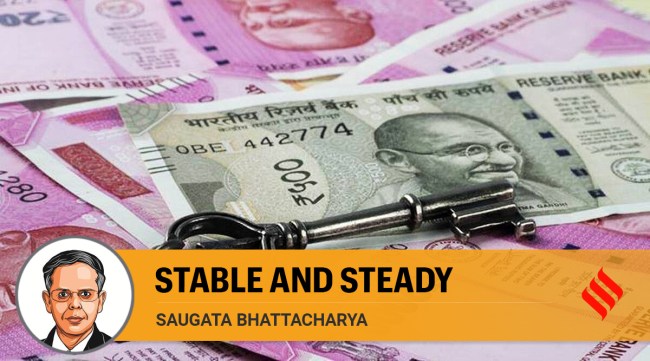Opinion Mixed signals on growth-inflation dynamics
Saugata Bhattacharya writes: Fortunately, India’s economy and policy matrix are well-positioned to manage multiple risks
 India’s growth–inflation dynamics are also becoming favourable, but are still subject to multiple risks. (File)
India’s growth–inflation dynamics are also becoming favourable, but are still subject to multiple risks. (File) The current economic cycle is a rare one, induced by a once-in-a-century public health shock. We are now at that point in the cycle where all central banks — the RBI, the US Fed, the European Central Bank, Bank of England and others — have begun to signal, in various stages of intensity, a process of normalisation from the unprecedented loose monetary policy stimulus post the onset of the pandemic in early 2020.
However, surveys and data prints are now signalling that the recovery momentum in the first half of 2021 is decelerating in many countries, although the direction and momentum may vary. In India, the minutes of the last Monetary Policy Committee meeting provide insights into the thinking on the economic environment. The RBI Governor notes that “the external environment, which had been supportive of aggregate demand over the past few months, may lose momentum for a variety of reasons”. The spillover channels are exports, financial markets volatility and imported inflation.
China — its policy and economy — is the most salient risk for a sustained global recovery. GDP growth in the July-September quarter printed at 4.9 per cent, lower than previous quarter’s 7.9 per cent, and is expected to be around 3.5 per cent for the ongoing quarter. The authorities’ seeming determination to push ahead with structural reforms, de-carbonising initiatives, and curbs on real estate appear designed to sacrifice some short-term growth for medium-term efficiencies, and reduce financial risks and inequality. At the same time, if growth were to slow too sharply, it would require a further round of stimulus.
Inflation in almost all major economies continues to remain high. The US Personal Consumption Expenditure (PCE) survey measure of core inflation — the Fed’s preferred gauge — is running over 4 per cent. The story is similar in Europe. Crude oil prices, from our perspective, remain the biggest concern, with the benchmark Brent price shooting up to $85 per barrel recently. A spike is also seen in natural gas, metals, minerals, ores, and select foods. This persistence is now prompting central bankers who had earlier consistently emphasised the “transitory” nature of this price shock, to re-evaluate their views. US Federal Reserve chairman described last month the scope and persistence of the supply-side dislocations as “frustrating” and a surprise.
Hence, in assessing India’s growth recovery, is there really a risk of the global economy going into “stagflation”? Stagflation (growth stagnation plus inflation) is an economic construct developed post the first oil shock of the early Seventies, when US inflation had soared to 11.5 per cent, even as the unemployment rate spiked to 9 per cent. The answer, going by US signals seems to be that if at all, it is likely to be mild. Inflation is already beginning to come off, with lumber (housing material) and iron ore (steel) prices sliding. On growth, labour markets remain tight, demand remains strong, balance sheets of companies are healthier, and household savings are elevated.
India’s growth–inflation dynamics are also becoming favourable, but are still subject to multiple risks. The recovery of economic activity continues, although the high-frequency indicators we track suggest that the momentum observed in July and August has moderated. It is difficult to separate how much of this is due to supply constraints and how much to demand scarring. For instance, although sales of passenger vehicles have slowed in September, reports of long wait times at dealerships suggest that demand for at least some segments remains robust, with continuing chip shortages disrupting production lines. Electricity consumption growth is also down from August levels, but part of this can be explained by both cooler, rainy weather, as well as coal shortage related cutbacks in many electricity-intensive manufacturing. These disruptions are now abating.
Conversations with retail companies indicate that both consumer non-durables (FMCG) and durables are doing well. Rural demand for FMCG has remained robust, post the rabi harvest and continuing government subventions, which are likely to continue with the largely normal ongoing kharif crop season. There is also a reported change in consumer demand for discretionary FMCG items, away from hygiene products. Urban demand is also reviving. Feedback from financing companies suggest that festive season demand for consumer loans is strong. As the economy opens up, with risk of a third wave receding, pent up demand for “contact” services in travel, tourism, entertainment, etc, is already evident.
The residential real estate is reportedly doing exceptionally well, with low-interest rates on home loans, cuts in stamp duty and registration charges, and indeed behavioural shifts towards own home ownerships with hybrid and work from home shifts. Even the commercial real estate sector is reviving, with demand from IT, tech, data centres, and city centre warehousing for e-commerce companies. The Union government also has large unspent cash balances, which can be judiciously deployed to boost both capex and consumption.
This brings us to the issue of demand recovery and price pressures. CPI inflation was high even before the start of the pandemic related lockdowns and disruptions in supply. At 7.4 per cent in December 2019, inflation had remained above or close to 6 per cent (the upper threshold of the MPC’s inflation target) for most of 2020. The last print of September 2021 came down to 4.35 per cent mostly due to lower food prices. Our assessment of the path of inflation going forward is very similar to the RBI’s forecasts — dipping lower in the third quarter, picking up thereafter. However, the overall trajectory suggests a gradual glide path towards the 4 per cent target by March 2023 or a bit beyond.
There are risks of overshooting this forecast trajectory, despite a benign outlook on food prices. This emanates from global metals, minerals, crude oil prices, and from supply bottlenecks persisting till well into 2022. The good news is that the responses to RBI’s household inflation survey suggests that the higher prices are still not embedded into expectations, which often influences consumer and producer behaviour towards higher prices and wages. At the same time, anecdotal evidence of labour market tightness in IT, tech, financial services, etc, is reportedly pushing up wages in these segments.
In summary, the growth–inflation signals remain mixed. Multiple episodes of global spillovers in the past couple of decades have taught us that imminent normalisation will have implications for all emerging markets. Fortunately, India’s economy and its policy matrix are now well-positioned to manage a range of plausible outcomes.
This column first appeared in the print edition on November 2, 2021 under the title ‘Stable and steady’. The writer is executive vice president and chief economist, Axis Bank. Views are personal







